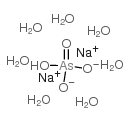砷酸氢二钠

砷酸氢二钠结构式

|
常用名 | 砷酸氢二钠 | 英文名 | SODIUM ARSENATE, HEPTAHYDRATE |
|---|---|---|---|---|
| CAS号 | 10048-95-0 | 分子量 | 312.01400 | |
| 密度 | 1,88 g/cm3 | 沸点 | N/A | |
| 分子式 | AsH15Na2O11 | 熔点 | 180 °C (dec.)(lit.) | |
| MSDS | 中文版 美版 | 闪点 | N/A | |
| 符号 |



GHS06, GHS08, GHS09 |
信号词 | Danger |
|
An in vitro method for estimation of arsenic relative bioavailability in soil.
J. Toxicol. Environ. Health A 76(7) , 458-78, (2013) This report summarizes the results of a study to develop an in vitro bioaccessibility (IVBA) extraction technique for estimating the relative bioavailability (RBA) of arsenic (As) in soil. The study was implemented in several steps. In step 1, key variables i... |
|
|
Measurement of arsenic relative bioavailability in swine.
J. Toxicol. Environ. Health A 76(7) , 449-57, (2013) This study describes a method for measuring the relative oral bioavailability (RBA) of arsenic (As) in soil and other soil-like media using young swine as the animal model. Groups of animals are exposed to site soil or sodium arsenate orally for 12 d. Forty-e... |
|
|
Arsenic alters behavioral parameters and brain ectonucleotidases activities in zebrafish (Danio rerio).
Comp. Biochem. Physiol. C. Toxicol. Pharmacol. 155(4) , 566-72, (2012) Arsenic (As) exposure has been associated with serious chronic health risk to humans including cancer and neurological disturbances. However, there are limited studies about the mechanisms behind its toxicity. In this study, adult zebrafish were exposed to se... |
|
|
Urinary arsenic speciation profiles in mice subchronically exposed to low concentrations of sodium arsenate in drinking water.
Kaohsiung J. Med. Sci. 27(9) , 417-23, (2011) Arsenic is a proven human carcinogen. Although the mechanism of its carcinogenicity is still largely unknown, methylation is thought to have an important role to play in arsenic toxicity. In this study, urinary methylation profiles were investigated in female... |
|
|
Indigenous soil bacteria with the combined potential for hydrocarbon consumption and heavy metal resistance.
Environ. Sci. Pollut. Res. Int. 19(3) , 812-20, (2012) Transconjugant bacteria with combined potential for hydrocarbon utilization and heavy metal resistance were suggested by earlier investigators for bioremediation of soils co-contaminated with hydrocarbons and heavy metals. The purpose of this study was to off... |
|
|
Embryotoxicity assessment of developmental neurotoxicants using a neuronal endpoint in the embryonic stem cell test.
J. Appl. Toxicol. 32(8) , 617-26, (2012) The embryonic stem cell test (EST) is a validated in vitro embryotoxicity test; however, as the inhibition of cardiac differentiation alone is used as a differentiation endpoint in the EST, it may not be a useful test to screen embryotoxic chemicals that affe... |
|
|
In vivo efficacy of ferrihydrite as an enterosorbent for arsenic: short-term evaluation in rodents.
J. Toxicol. Environ. Health A 76(3) , 167-75, (2013) The use of dietary adsorbents to reduce arsenic (As) exposure is innovative. Ferrihydrite successfully sorbs arsenite and asenate over a wide range of pH conditions and the As-ferrihydrite complexes are stable in gastrointestinal (GIT) models. Our objectives ... |
|
|
The effect of normoxia and hypoxia on a prostate (PC-3) CD44/CD41 cell side fraction.
Anticancer Res. 31(2) , 487-94, (2011) It has been reported that human prostate-derived PC-3 cells that are CD44- and CD 41 (a2 B1)-positive are enriched in cancer stem cells. This study compared the effect of PC-3 cell proliferation under normoxia or hypoxia on the initial and subsequent expressi... |
|
|
Arsenate V induced glutathione efflux from human erythrocytes.
J. Trace Elem. Med. Biol. 26(1) , 53-8, (2012) The objective of the present study was to investigate if arsenate V exposure results in glutathione efflux from human erythrocytes.The changes in intracellular and extracellular nonprotein sulfhydryl and glutathione levels were determined in arsenate (V) expo... |
|
|
Indian spice curcumin may be an effective strategy to combat the genotoxicity of arsenic in Swiss albino mice.
Asian Pac. J. Cancer Prev. 11(1) , 239-47, (2010) Inorganic arsenic (As) is considered as a human carcinogen because it is associated with cancers of skin, lung, liver and bladder in exposed population. Consumption of As contaminated ground water for long term causes oxidative stress. Generation of reactive ... |